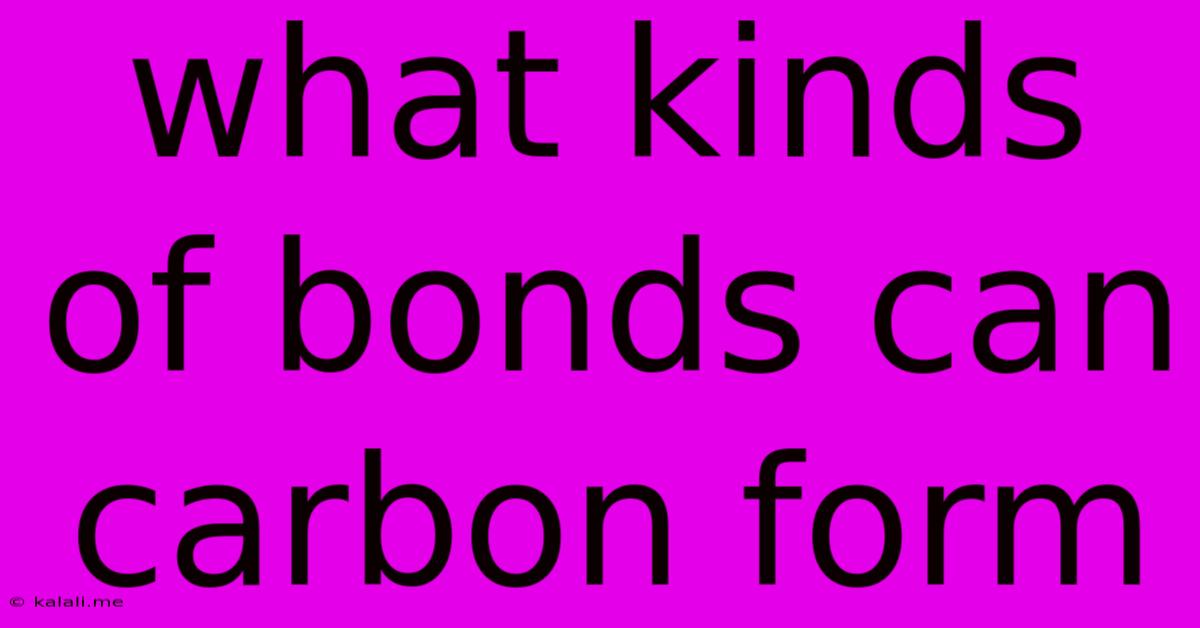What Kinds Of Bonds Can Carbon Form
Kalali
May 10, 2025 · 3 min read

Table of Contents
The Amazing Bonding Capabilities of Carbon: Exploring Carbon's Diverse Chemical Bonds
Carbon, the backbone of life and a cornerstone of countless materials, possesses a remarkable ability to form a diverse array of chemical bonds. This versatility is the key to its extraordinary importance in chemistry, biology, and materials science. Understanding the types of bonds carbon can form is fundamental to grasping its crucial role in the world around us. This article will explore the various ways carbon atoms connect, focusing on the strength, stability, and resulting structures.
What makes carbon so special? Carbon's unique bonding properties stem from its electronic configuration. With four valence electrons, carbon can readily form four covalent bonds. This tetravalency, along with its relatively small atomic size, allows for the formation of strong, stable bonds with a wide range of elements, including itself.
1. Single Bonds (C-C): The Foundation of Organic Chemistry
The simplest and most fundamental type of carbon-carbon bond is the single bond, also known as a sigma (σ) bond. This involves the sharing of one electron pair between two carbon atoms. Single bonds are relatively weak compared to double and triple bonds, allowing for free rotation around the bond axis. Long chains, branched structures, and ring systems are all built upon the foundation of single carbon-carbon bonds. This forms the basis of the vast field of organic chemistry, encompassing everything from simple hydrocarbons to complex biomolecules like proteins and DNA.
Examples include:
- Ethane (C₂H₆): A simple hydrocarbon with a single C-C bond.
- Polyethylene: A long chain polymer consisting of repeating C-C single bonds.
2. Double Bonds (C=C): Introducing Unsaturation
Carbon atoms can also form double bonds, characterized by the sharing of two electron pairs. One bond is a sigma (σ) bond, while the other is a pi (π) bond formed by the sideways overlap of p-orbitals. Double bonds are stronger and shorter than single bonds, introducing rigidity to the molecule. The presence of double bonds introduces unsaturation into a molecule, altering its reactivity and properties.
Examples include:
- Ethene (C₂H₄): A simple alkene with a carbon-carbon double bond.
- Fatty acids: Contain carbon-carbon double bonds, influencing their properties (e.g., fluidity of fats and oils).
3. Triple Bonds (C≡C): Strongest and Shortest
The strongest and shortest carbon-carbon bond is the triple bond, formed by the sharing of three electron pairs: one sigma (σ) bond and two pi (π) bonds. Triple bonds confer significant rigidity and a high degree of unsaturation. These bonds are found in alkynes, a class of unsaturated hydrocarbons.
Examples include:
- Ethyne (C₂H₂): A simple alkyne containing a carbon-carbon triple bond.
4. Bonds with Other Elements
Beyond carbon-carbon bonds, carbon forms strong covalent bonds with numerous other elements, notably:
- Carbon-Hydrogen (C-H): Extremely common in organic molecules, these bonds are relatively non-polar and relatively strong.
- Carbon-Oxygen (C-O): Found in alcohols, ketones, aldehydes, carboxylic acids, and esters, these bonds are polar and play crucial roles in biological and chemical processes.
- Carbon-Nitrogen (C-N): Crucial in amino acids, proteins, and many other organic molecules, these bonds are also relatively polar.
- Carbon-Halogen (C-X, where X = F, Cl, Br, I): These bonds are polar and the strength varies depending on the halogen.
- Carbon-Sulfur (C-S): Present in amino acids like cysteine and various other organic compounds.
Conclusion:
The remarkable ability of carbon to form single, double, and triple bonds with itself and other elements underpins its central role in chemistry and biology. The strength, length, and polarity of these bonds dictate the properties of molecules, leading to the immense diversity of organic compounds and their countless applications. Understanding carbon's bonding capabilities is crucial for comprehending the structure and function of biological systems and the design and synthesis of novel materials.
Latest Posts
Latest Posts
-
How Far Is 0 4 Miles To Walk
Jul 12, 2025
-
What Is 20 Percent Of 800 000
Jul 12, 2025
-
Words That Start With Y In Science
Jul 12, 2025
-
Prevent An Expressway Emergency By Merging Without
Jul 12, 2025
-
How Many Grams Of Sugar In A Pound
Jul 12, 2025
Related Post
Thank you for visiting our website which covers about What Kinds Of Bonds Can Carbon Form . We hope the information provided has been useful to you. Feel free to contact us if you have any questions or need further assistance. See you next time and don't miss to bookmark.